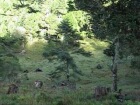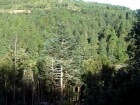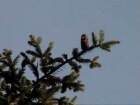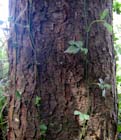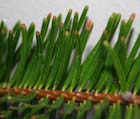Abies guatemalensis
Rehder 1939
Common names
Guatemalan fir, pashaque fir; Abeto de Guatemala, pinabete, romerillo [Spanish], pacachaque, parchac [indigenous language uncertain](Asociación Becaria Guatemalteca 1995, Williams 1981).
Taxonomic notes
Synonymy (Farjon 1998):
- Abies tacanensis Lundell 1940;
- Abies guatemalensis Rehder var. tacanensis (Lundell) Martínez 1963;
- Abies guatemalensis Rehder var. longibracteata Debreczy et Rácz 1995;
- Abies guatemalensis Rehder var. tamaulipensis Silba 1997;
- Abies religiosa (Kunth) Schlechtendahl et Chamisso subsp. guatemalensis (Rehder) K. Strandby, K.I. Christensen, et M. Sørensen 2009.
The taxon formerly referred to as A. guatemalensis var. jaliscana is now a synonym pro parte for A. flinckii and A. jaliscana.
Description
Trees up to 45 m tall and 100 cm dbh. Primary branches horizontal branches. Bark black-brown, divided into plates. Branchlets red-brown to deep black-red, pubescent. Buds globular-ovoid, resinous, to 5 mm long. Leaves spirally arranged, ±pectinate, linear, dark green above, glaucous beneath, 1.5-5.5 cm × 1.2-2 mm; stomata usually absent above, in 8-10 lines below; resin canals 2, marginal; apex notched and emarginate. Female cones subsessile, oblong-cylindric, apex pointed to somewhat flattened, yellowish-brown with a violet bloom, 8-12 × 4-4.5 cm; scales oblong, broader than long; bracts hidden, about 1/2 length of scale, cuneate-obovoid. Seeds light brown, to 9 mm long, wing to 15 mm long" (Dallimore et al. 1967, Rzedowski 1981, Silba 1986). Flowers May-June (Macvean 2003).
Distribution and Ecology
El Salvador, W Guatemala (Quiché, Chichicastenango, Totonicapán, Sololá, Huehuetenango, Quetzaltenango, San Marcos, Jalapa), Honduras (the Santa Barbara Mountains) and Mexico (Chiapas, Colima, Guerrero, Oaxaca, Querétaro, San Luis Potosí, Tamaulipas) (Asociación Becaria Guatemalteca 1995, Farjon 1998) at 1800-4083 m (Silba 1986). This has the most southerly distribution of any species in the genus (Donahue et al. 1985).
Distribution data from GBIF.org, downloaded 2017.11.04.
It is a mountain species, associated primarily with Pinus ayacahuite, P. hartwegii, and Hesperocyparis lusitanica (Perry 1991), growing in areas that have annual rainfall of more than 1000 mm in moderately acidic soils, pH 5.4-5.7 (Rzedowski 1981, Donahue et al. 1985). Although remaining stands are protected and cutting is prohibited, its distribution is limited by exploitation (Macvean 2003), including cutting for construction, firewood and charcoal (Donahue et al. 1985).
Hardy to Zone 9 (cold hardiness limit between -6.6°C and -1.1°C) (Bannister and Neuner 2001).
This species is listed as endangered in Mexico under NOM-ECOL-059-94.
Remarkable Specimens
The oldest recorded tree seems to have 311 years of record, for a crossdated tree-ring chronology ending in 2010, collected in western Guatemala (Anchukaitis et al. 2013). It is possible that the tree was not alive at the time of sampling, but the authors do not mention sampling any dead trees and their Figure 4(e) shows that the oldest sampled tree was something over 300 years.
Ethnobotany
Illegal extraction of forest products is severely degrading the forest of Los Altos de San Miguel Totonicapán in Guatemala, which is said to harbor the largest and best-conserved stand of Abies guatemalensis in Guatemala (CONAP/INAB, 1999). Commercial harvest of fir branches is prohibited and punishable under Guatemala's Forestry Law (1996), but the high demand for fir branches during Christmas encourages people to illegally harvest this species. An estimated 70% of the firs in the regional forest have been affected to some degree by illegal cutting (ParksWatch 2004).
Observations
No data as of 2023.02.22.
Remarks
This species is listed as endangered by the Mexican government (NOM-ECOL-059-94), is listed on Appendix 1 of CITES, and is protected from harvest in Guatemala (ParksWatch 2004).
Donahue et al. (1985, cited in Macvean 2003) state that trees mast about every two years. They recommend collecting cones from November through January, when the cones are nearly mature as shown by purple-green color and the appearance of resin drops. Fully ripe cones quickly disintegrate. To mature cones, keep them in shade for 8 weeks and extract seed. Six hours exposure to sunlight dries the seeds enough to allow long-term storage. Seeds average 35-42,000 per kg. Fresh gemination rate is about 15%, typical for Abies species, and 1 year of cold storage drops germination to 2%. Proper stratification (described by Macvean 2003) can improve germination to over 30%.
Notable pests afflicting this species include bark beetles (Dendroctonus spp.) and seed wasps (Megistimus spp.) (Donahue et al. 1985, Hiratsuka et al. 1995).
Citations
Anchukaitis, Kevin J., Matthew J. Taylor, Javier Martin-Fernandez, Diego Pons, Malcolm Dell, Christopher Chopp, and Edwin J. Castellanos. 2013. Annual chronology and climate response in Abies guatemalensis Rehder (Pinaceae) in Central America. The Holocene 23(2):270-277.
Asociación Becaria Guatemalteca. 1995. Guauhitemala, Lugar de bosques. [City
unknown],Guatemala: Editorial Piedra Santa. 67 p. Vol. 1.
CONAP/INAB, 1999. Diagnóstico de las poblaciones de pinabete (Abies guatemalensis R.) en Guatemala y estrategia para su conservación. Consejo Nacional de Áreas Protegidas, Instituto Nacional de Bosques, USAID. Guatemala [cited in ParksWatch 2004].
Donahue, J.K.; Dvorak, W.; Gutierrez, E.; Kane, M. 1985. Abies guatemalensis: a two-year status report. CAMCORE Bulletin. Raleigh, NC: North Carolina State University, School of Forest Resources. 19 p.
Hiratsuka, Y., D.W. Langor, and P.E. Crane. 1995. A field guide to forest insects and diseases of the prairie provinces. Special Report 3. Canada: Canadian Forest Service.
297 p.
Macvean, Ana Lucrecia E. de 2003. Abies guatemalensis. Species description in the Tropical Tree Seed Manual. Available http://www.rngr.net/Publications/ttsm/Folder.2003-07-11.4726 (accessed 2007.08.31).
Rehder, A. 1939. The firs of Mexico and Guatemala. Journal of the Arnold Arboretum 20:281-287. Available: Biodiversity Heritage Library, accessed 2021.12.19.
Rushforth, K.D. 1989. Two new species of Abies (Pinaceae) from western Mexico. Notes RBG Edinb. 46(1):101-109.
Rzedowski, J. 1981. Vegetación de México. México, D.F.: Editorial Limusa. 432 p.
Williams, L.O. 1981. The useful plants of Central America. CEIBA 24(1-2): 265-266.
See also
Farjon, Aljos. 1990. Pinaceae: drawings and descriptions of the genera Abies, Cedrus, Pseudolarix, Keteleeria, Nothotsuga, Tsuga, Cathaya, Pseudotsuga, Larix and Picea. Königstein: Koeltz Scientific Books.
- Provides a detailed account, with illustrations.
Vidakovic (1991).
